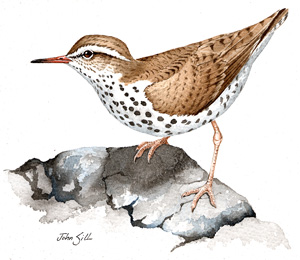Breeding Bird Atlases (BBA)
Find a Bird
Spotted Sandpiper
Actitis macularius

Fairly widespread and likely increasing
“All my life I have lived and behaved very much like the sandpiper – just running down the edges of different countries and continents, ‘looking for something’.” – Elizabeth Bishop
From the Aleutian Islands south to California and east all the way to Virginia, the Spotted Sandpiper can be found breeding in more places in North America than any other sandpiper. This species, which is also known as the “spotty,” “teeter-peep,” “teeter-bob,” “teeter-up,” and a host of other names, is a relatively common sight in both salt- and freshwater habitats. These evocative monikers come from the species’ habit of constantly bobbing its tail as it walks along the water’s edge looking for invertebrate prey.
Historic Status
When late nineteenth-century gunners set themselves up on beaches to kill shorebirds, they often took Spotted Sandpipers. Unlike many shorebirds, though, the Tip-ups, as they were often called, largely survived the storm of shot, perhaps due to their solitary nature when foraging. Forbush, in an independent and unscientific survey, noted that his correspondents in the first three decades of the twentieth century voted 59 to 15 that a decrease in the Massachusetts population may have taken place (Forbush 1912), but that decrease never took a disastrous turn. After weathering the era of heavy shorebird hunting with relatively few casualties, the Spotted Sandpiper remained widespread and fairly common as a breeder in Massachusetts.
Atlas 1 Distribution
The Spotted Sandpiper’s solitary habits, small size, and willingness to accept almost any wet habitat for nesting placed it in a much better position during Atlas 1 than many of the other sandpiper species breeding in Massachusetts. In the western part of the state, far from sandy coastal beaches, this species could be found breeding in every ecoregion, particularly the lower-elevation Marble Valleys and Connecticut River Valley. Not as many Spotted Sandpipers probed the mud of the Worcester and Lower Worcester Plateaus, but the Coastal Plains and Boston Basin both had over 30% block occupancy. The Bristol/Narragansett Lowlands and the Cape and Islands had slightly lower proportions of occupied blocks, though Spotted Sandpipers were clearly still present.
Atlas 2 Distribution and Change
While the Spotted Sandpiper remains a fairly widespread breeder in the state, its pattern of block occupancy appears somewhat unstable. Atlas 2 found Spotted Sandpipers in 35% of the blocks surveyed, while Atlas 1 found them in just 29%. Data from only the best-surveyed blocks show that Spotted Sandpipers disappeared from 17% of the blocks surveyed, and were newly recorded in 22% of all blocks. While still a net gain for the species, these numbers suggest considerable “shuffling” of the Spotted Sandpiper’s distribution between the Atlases. The Spotted Sandpiper is not evenly distributed across the state; instead it favors the Coastal Plains and Boston Basin and is underrepresented on the Cape and Islands. The Cape is also the only region to show a net loss in the percent of blocks occupied for this species. Even so, across many of the regions in the west, such as the Marble Valleys, Spotted Sandpipers still showed a net gain in total blocks occupied.
Atlas 1 Map

Atlas 2 Map

Atlas Change Map

Ecoregion Data
Atlas 1 | Atlas 2 | Change | ||||||
Ecoregion | # Blocks | % Blocks | % of Range | # Blocks | % Blocks | % of Range | Change in # Blocks | Change in % Blocks |
Taconic Mountains | 1 | 6.3 | 0.4 | 1 | 4.0 | 0.3 | 0 | 0.0 |
Marble Valleys/Housatonic Valley | 21 | 53.8 | 7.6 | 14 | 35.9 | 3.9 | -7 | -17.9 |
Berkshire Highlands | 15 | 27.3 | 5.5 | 23 | 41.8 | 6.4 | 8 | 15.1 |
Lower Berkshire Hills | 4 | 14.3 | 1.5 | 7 | 22.6 | 1.9 | 3 | 11.1 |
Vermont Piedmont | 3 | 17.6 | 1.1 | 7 | 41.2 | 1.9 | 2 | 16.7 |
Berkshire Transition | 7 | 18.4 | 2.5 | 9 | 22.5 | 2.5 | 1 | 3.2 |
Connecticut River Valley | 19 | 33.9 | 6.9 | 31 | 47.7 | 8.6 | 9 | 18.8 |
Worcester Plateau | 14 | 17.9 | 5.1 | 27 | 30.7 | 7.5 | 4 | 8.3 |
Lower Worcester Plateau | 19 | 25.7 | 6.9 | 26 | 32.5 | 7.2 | 6 | 11.1 |
S. New England Coastal Plains and Hills | 82 | 30.4 | 29.8 | 128 | 45.2 | 35.4 | 25 | 11.1 |
Boston Basin | 22 | 39.3 | 8.0 | 34 | 60.7 | 9.4 | 11 | 20.0 |
Bristol and Narragansett Lowlands | 30 | 28.3 | 10.9 | 30 | 26.3 | 8.3 | -1 | -1.0 |
Cape Cod and Islands | 38 | 27.9 | 13.8 | 25 | 17.4 | 6.9 | -14 | -11.7 |
Statewide Total | 275 | 28.4 | 100.0 | 362 | 34.9 | 100.0 | 47 | 5.7 |
Notes
The Spotted Sandpiper shows a significant decreasing Breeding Bird Survey trend in the Eastern US overall.



